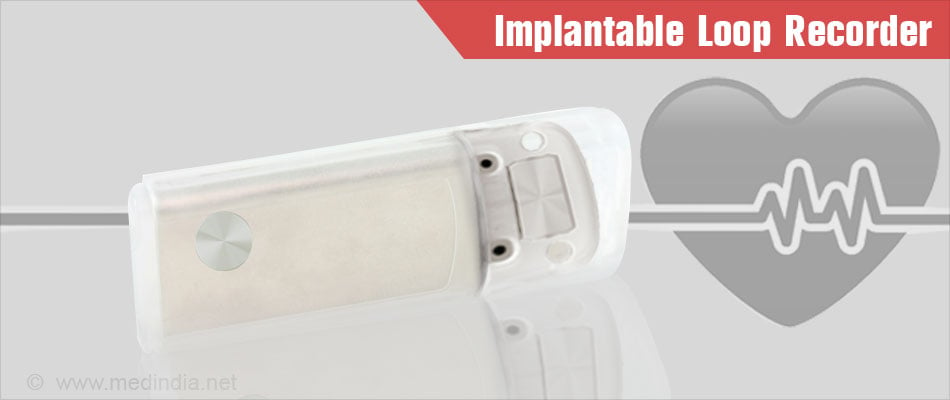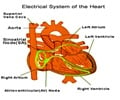- Mofrad, P.S., Implantable loop monitors: patient perspective. Circulation, 2012. 126(25): p. e472-4.
- Implantable Loop Recorder (ILR) - (http://www.brighamandwomens.org/departments_and_services/heart-and-vascular-center/procedures/implantable-loop-recorder.aspx)
- Cardiac Event Recorder - (http://www.heart.org/heartorg/conditions/arrhythmia/preventiontreatmentofarrhythmia/cardiac-event-recorder_ucm_447317_article.jsp#.v2udsrh97iu)
- Implantable Loop Recorder (ILR) - - (http://www.brighamandwomens.org/Departments_and_Services/heart-and-vascular-center/procedures/implantable-loop -recorder.aspx)
- Cock, C. C. (2002). The implantable loop recorder: A tool that is "here to stay."Indian Pacing and Electrophysiology Journal, 2(1), 15-19.
- Giada, F., et al., Recurrent unexplained palpitations (RUP) study comparison of implantable loop recorder versus conventional diagnostic strategy. J Am Coll Cardiol, 2007. 49(19): p. 1951-6.
- Cotter, P. E., Martin, P. J., Ring, L., Warburton, E. A., Belham, M., & Pugh, P. J. (2013). Incidence of atrial fibrillation detected by implantable loop recorders in unexplained stroke. Neurology, 80(17), 1546-1550. http://doi.org/10.1212/WNL.0b013e31828f1828
- Implantable Loop Recorder (ILR) - (http://my.clevelandclinic.org/services/heart/disorders/syncope)
What is an Implantable Loop Recorder?
Implantable Loop Recorder (ILR) or Insertable Cardiac Monitor is a small implantable device which monitors electrical heart activity and records the arrhythmias. It is a USB-sized device.
Abnormal heart rhythm is called arrhythmia. There are many devices to evaluate the electrical rhythm of the heart.

- The Electrocardiogram (ECG) is a routine test which aids in the recording of the electrical activity of heart. ECG alone is not adequate in patients who experience arrhythmias less frequently.
- Holter Monitoring helps in the continuous electrocardiographic (the graphical record of electrical heart activity) recording for 24-48 hours or more.
- Cardiac event recorder is a portable external device, which helps to record the electrical activity of the heart whenever the patient experiences the symptoms. Cardiac event monitor helps to detect the arrhythmias, which occur less than daily.
- Implantable Loop Recorder (ILR) is an implantable device that can be used in patients with arrhythmias, which occur once in months or year.
What are the Uses of ILR?
ILR is useful in patients who present with the following symptoms and when ECG, 24 hour Holter monitor or a 30-day event monitor are not enough to capture the problem because of the less frequent occurrence.
- Recurrent Unexplained Syncope: Syncope is temporary unconsciousness. It can be due to multiple reasons. Cardiac causes of syncope are arrhythmias, obstructed blood flow within the heart, heart failure, myocardial infarction, diseases of the valves of the heart, cardiomyopathies, aortic stenosis or blood clot. The diagnostic tests like electrocardiogram and echocardiogram can help to detect the underlying cause of the cardiac syncope. ILR is useful in recurrent unexplained syncope.
- Recurrent Palpitations: In patients with infrequent unexplained palpitations, ILR is safe and cost effective diagnostic option.

- Cryptogenic Stroke: ILR is found to be useful in patients with unexplained stroke (decrease in the blood supply to the brain) due to undetected atrial fibrillation.
- Atrial Fibrillation: In patients with Atrial Fibrillation ILR can be used as a monitoring device.
The battery life of the ILR is two years which gives ample time to detect the problem and hence it allows the physician to diagnose the condition to provide proper treatment.
How does the ILR work?
ILR records the electrical heart activity. It works by two ways.
ILR monitors the heart rhythm and records any rhythm that crosses the set threshold parameters in the device. ILR records both the tachyarrhythmias (abnormal increase in the electrical heart activity) and bradyarrhythmias (abnormal decrease in the electrical heart activity).
ILR also records the electrical heart activity when the patient triggers the patient activator. The patient should trigger the activator after placing it close to the chest and near the ILR. The patients are instructed to trigger when they experience lightheadedness, dizziness or skipped beats.
How is ILR placed?
The implantation of ILR is performed in the hospital. It is done under complete aseptic precautions and local anesthesia. The area left to the breastbone and below the collar is cleaned sterile. A local anesthetic agent is injected at the incision site. A skin incision of about 1-2 cm is made, and a pocket is created below the skin to hold the device. ILR is placed in the pocket; skin is sutured and dressed. It takes around 20-30 minutes to implant ILR.
What to Expect after the Procedure?
- The discharge is usually on the same day of the procedure.
- The doctor usually suggests the patient for a check-up after 1-2 weeks to make sure that the incision has healed. Later, the patient will be asked to visit once every three months.The device will be programmed to a threshold heart rate level to detect the low and high heart rates. It will be programmed to detect the arrhythmias.
- The device records when the heart rhythm reaches the set programmed parameters and also when the patient triggers the activator.
- The device check is called interrogation. Interrogation can be done at physician’s office or remotely from the patient’s place.

What are the Precautions for Patients with Implantable Loop Recorders?
No special precautions are necessary. ILR does not interact with electronics like microwave ovens, laptops, washers, phones or metal detectors. It is suggested to carry an ILR Id card. The card helps when the patient travels and has to go through the metal detectors. Id card allows the doctor in the emergency room to find the abnormal recordings during the symptoms.
What are the Advantages of ILR over other Diagnostic Tests?
ILR can be useful for a longer time. Once it is implanted, it can be a useful tool for around two years. In patients with arrhythmias that occur once in months or more, it can be the best diagnostic tool. Since it is an implantable device, the patient compliance issues are minimal.





